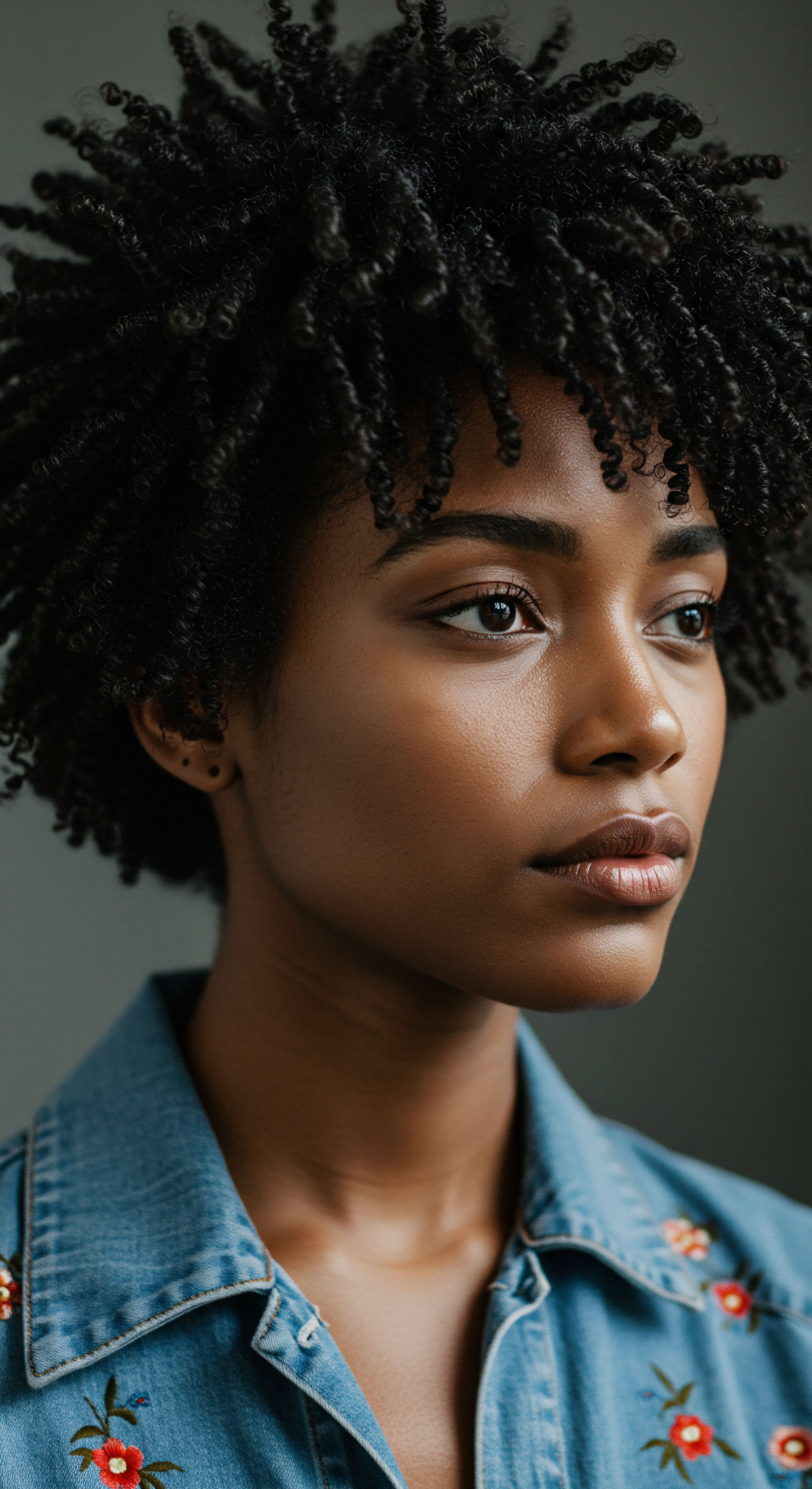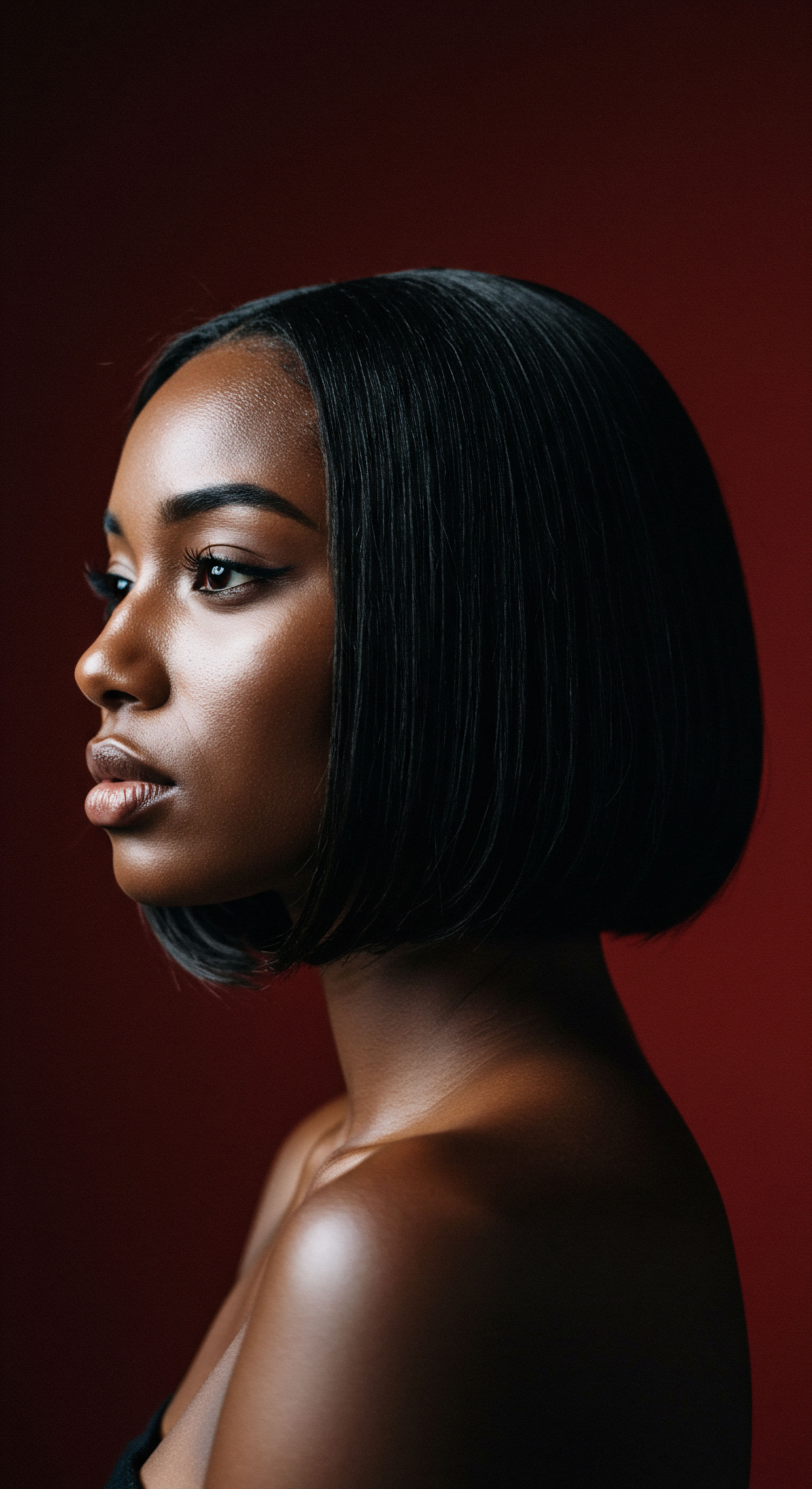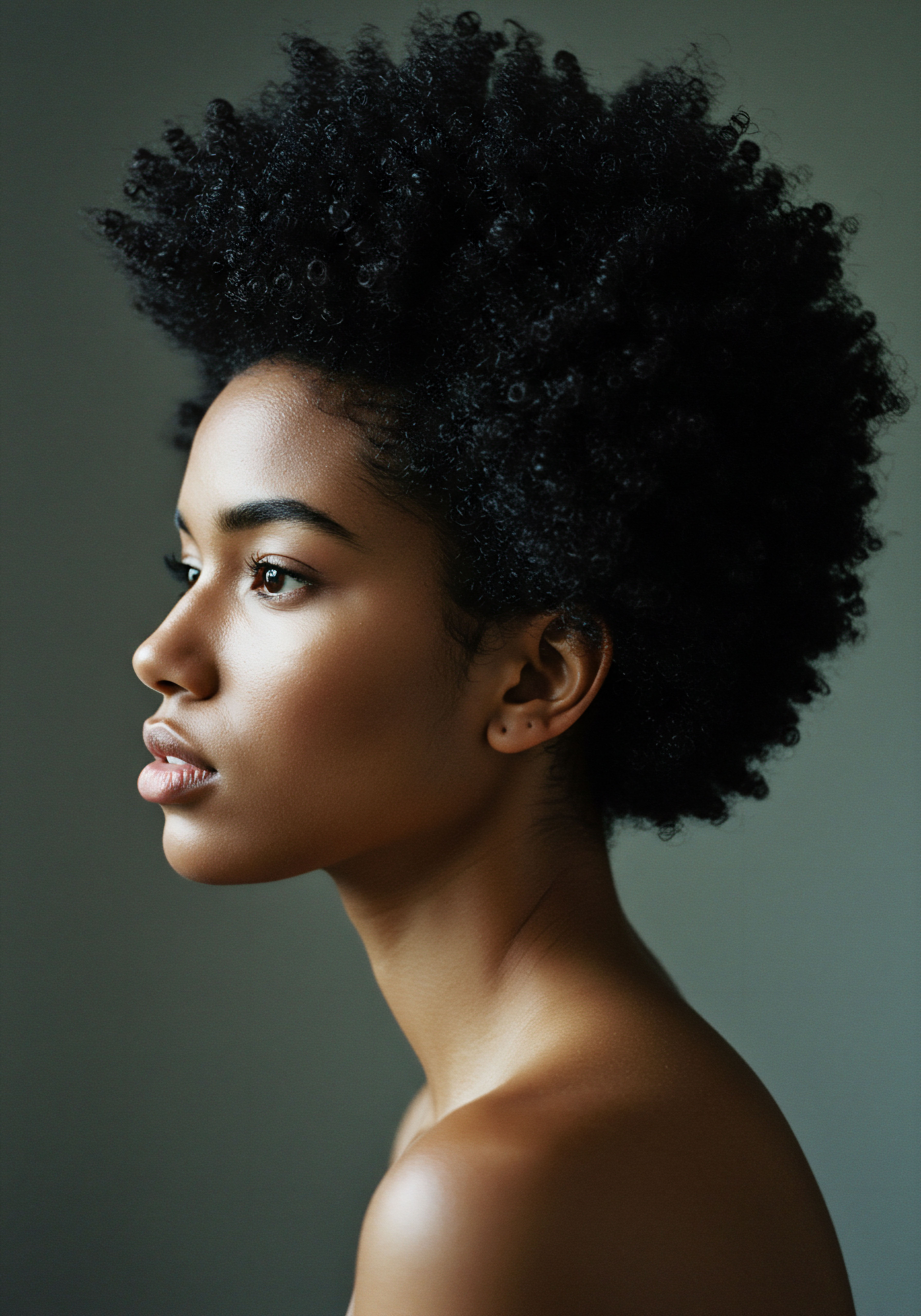
Roots
The journey of textured hair, with its inherent spirals, coils, and waves, holds a profound story within each strand. For generations, individuals have sought to reshape this natural design, driven by evolving beauty ideals, cultural pressures, or simply a desire for versatility. The practice of chemically altering hair to achieve a straightened appearance carries a complex history, intertwined with societal perceptions of beauty and professionalism. Understanding the documented health considerations linked to long-term chemical hair straightening requires us to look beyond the surface, delving into the very foundations of hair structure and the chemical processes that seek to reconfigure it.
Our hair, at its essence, is a protein filament, primarily composed of keratin. This protein, arranged in a specific molecular architecture, gives each strand its unique curl pattern. Chemical straighteners, often referred to as relaxers, function by breaking the very bonds that give hair its curl. These are disulfide bonds, strong chemical connections that maintain the hair’s shape.
Once these bonds are disrupted, the hair can be mechanically straightened, and then new bonds are formed to hold the altered configuration. This process, while seemingly straightforward in its aim, involves potent chemical agents that interact not only with the hair shaft but also with the delicate skin of the scalp.

The Architecture of a Strand
A single hair strand, deceptively simple in appearance, consists of three main layers ❉ the medulla, the cortex, and the cuticle. The outermost layer, the Cuticle, comprises overlapping scales that shield the inner structures. Beneath this protective shield lies the Cortex, the primary determinant of hair’s strength, elasticity, and curl pattern. This is where the disulfide bonds reside, forming the backbone of a curl.
The innermost layer, the Medulla, is often absent in finer hair types. When chemical straighteners are applied, their action targets the cortex, aiming to dismantle those inherent disulfide bonds.

Historical Context of Hair Alteration
The pursuit of altered hair textures is not a modern phenomenon. Throughout history, various cultures have employed methods to straighten or curl hair, often using heat, natural ingredients, or mechanical tension. The advent of modern chemical straighteners in the early 20th century, particularly those marketed towards Black women, marked a significant shift. These products offered a seemingly convenient path to a straightened style, responding to a complex interplay of personal preference and societal norms.
Garrett Morgan, an African American businessman, developed one of the earliest hair straightening creams in the early 1900s, initially while seeking a solution for sewing machine friction. This innovation, among others, paved the way for widespread commercial availability of these products. Over 70% of Black women, for instance, have used hair straighteners, according to research published in Environmental Health Perspectives.
The historical quest for hair alteration, particularly chemical straightening, is deeply rooted in cultural contexts and evolving beauty standards.
The chemicals employed in these early formulations, and indeed many present-day versions, were designed to be powerful. Their effectiveness in breaking down the hair’s natural structure also means they possess a reactive nature, capable of interacting with biological systems beyond the hair itself. This foundational understanding of hair’s composition and the chemical assault it undergoes is crucial for comprehending the broader health implications that extend far beyond a desired aesthetic.

Ritual
The application of chemical hair straighteners often becomes a recurring ritual, a patterned practice woven into the fabric of personal care. This periodic process, undertaken in salons or at home, involves the deliberate application of strong chemical formulations to the scalp and hair. The immediate sensations during this process—a tingling, a warmth, sometimes even a sharp discomfort—are often accepted as part of the transformative experience. Yet, beneath the surface of this familiar ritual, complex chemical interactions unfold, carrying implications that extend beyond the hair shaft itself.

Chemical Agents and Their Actions
Chemical straighteners, broadly categorized as relaxers or thermal reconditioning treatments, rely on potent chemical compounds to achieve their effects.
- Lye Relaxers ❉ These typically contain Sodium Hydroxide, a strong alkaline chemical. It rapidly breaks the disulfide bonds within the hair’s cortex, allowing the hair to be reshaped. While highly effective, sodium hydroxide is also known for its caustic properties, capable of causing chemical burns and irritation upon contact with the skin and scalp.
- No-Lye Relaxers ❉ Formulations like calcium hydroxide, often paired with guanidine carbonate, provide an alternative to lye. While marketed as gentler, these too operate by breaking disulfide bonds and can lead to scalp dryness and irritation.
- Thio Relaxers ❉ Utilizing compounds such as Ammonium Thioglycolate, these products work by reducing the disulfide bonds, then reforming them into a straight configuration with a neutralizer. Japanese heat straightening, for example, often uses ammonium thioglycolate.
- Keratin Treatments and Formaldehyde Releasers ❉ Brazilian keratin treatments aim to smooth hair rather than permanently straighten it by coating the hair and often involve formaldehyde or formaldehyde-releasing chemicals. These chemicals, when heated, release gaseous formaldehyde, a known human carcinogen.
The application process typically involves parting the hair, coating sections with the chemical cream, and allowing it to process for a set time, often accompanied by careful smoothing to encourage the straight configuration. A neutralizing agent then follows, halting the chemical reaction and setting the new shape. The immediate side effects are frequently localized, affecting the scalp and hair itself.
The ritual of chemical hair straightening relies on potent compounds that alter hair structure, often causing immediate scalp and hair reactions.

Immediate Physical Responses
Many individuals who use chemical straighteners report a range of immediate physical responses. These can include:
- Scalp Irritation and Burns ❉ The strong alkaline nature of many relaxers can cause significant irritation, redness, stinging, and even chemical burns on the scalp. This is particularly true if the product is left on too long, if the scalp has pre-existing abrasions, or if protective measures are insufficient.
- Hair Damage and Breakage ❉ The process of breaking and reforming disulfide bonds inherently stresses the hair shaft. This can result in dryness, brittleness, increased frizz, and breakage, sometimes leading to thinning or even temporary hair loss.
- Skin and Eye Irritation ❉ Accidental contact with the chemicals can cause redness, watering, itching, and burning in the eyes, as well as irritation and rashes on other skin areas.
These acute effects are often seen as temporary inconveniences, a necessary discomfort for the desired aesthetic. However, the recurring nature of the straightening ritual means these acute exposures are repeated over months and years, setting the stage for deeper, less immediately apparent health considerations. The scalp, with its rich blood supply and hair follicles, can readily absorb chemicals, especially when its protective barrier is compromised by burns or irritation. This increased absorption becomes a critical pathway for chemical entry into the body, transforming a topical application into a systemic exposure over time.

Relay
Beyond the visible transformation of hair and the immediate sensations of a straightening session, lies a more complex and often unseen relay of effects within the body. This deeper exploration moves us from the immediate physical changes to the subtle, yet potentially significant, biological and systemic shifts that can unfold over years of consistent chemical hair straightening. Here, the interplay of chemical absorption, hormonal disruption, and long-term cellular responses takes center stage, revealing a compelling narrative of health considerations that warrant our careful attention.

How Do Hair Straightener Chemicals Interact With the Body?
The chemicals within hair straighteners do not remain confined to the hair shaft. Applied directly to the scalp, these substances can penetrate the skin, entering the bloodstream and circulating throughout the body. This absorption is particularly concerning when the scalp experiences burns, lesions, or irritation, as these conditions compromise the skin’s natural barrier, creating easier pathways for chemical entry. The very nature of the straightening process, which can cause discomfort and scalp damage, inadvertently facilitates a greater internal exposure.
A range of potentially harmful chemicals have been identified in hair straightening products. These include, but are not limited to:
- Formaldehyde and Formaldehyde Releasers ❉ Known human carcinogens, these compounds can be inhaled as gases during application, causing respiratory issues and carrying a cancer risk.
- Parabens ❉ Often used as preservatives, parabens like methylparaben, ethylparaben, propylparaben, and butylparaben are classified as endocrine-disrupting chemicals (EDCs). They can mimic estrogen in the body, potentially altering hormonal balance.
- Phthalates ❉ These chemicals, such as diethylhexylphthalate (DEHP), are used to enhance product performance and fragrance longevity. They are also EDCs, linked to hormonal disruptions and reproductive issues.
- Sodium Hydroxide (Lye) and Guanidine Hydroxide ❉ While primarily acting on hair, their caustic nature can cause scalp burns, which in turn facilitate the entry of other chemicals.
- Cyclosiloxanes ❉ Another group of chemicals found in some relaxers, also associated with endocrine disruption.
These chemicals, once absorbed, can interfere with various bodily systems, particularly the endocrine system, which regulates hormones.

What Are the Reproductive and Hormonal Implications?
One of the most significant areas of concern relates to reproductive and hormonal health. Research suggests a connection between long-term use of chemical hair straighteners and several conditions:

Uterine Fibroids
Uterine fibroids, non-cancerous growths in the uterus, are disproportionately common among Black women, often appearing at earlier ages and presenting with more severe symptoms. Studies have indicated a link between hair relaxer use and an increased risk of these growths. For instance, a 2012 study published in the American Journal of Epidemiology observed that women who used hair relaxers were 17% more likely to develop fibroids compared to those who never used them.
The risk increased with the duration and frequency of relaxer use, particularly with a higher number of reported scalp burns. This suggests a dose-response relationship, where greater exposure correlates with higher risk.

Early Menstruation and Reproductive Disorders
The endocrine-disrupting chemicals (EDCs) found in many straighteners, such as parabens and phthalates, can mimic or interfere with natural hormones like estrogen. This hormonal interference has been linked to the early onset of menstruation and other reproductive health issues. Such early hormonal shifts can have cascading effects on reproductive development and long-term health.

Are There Cancer Connections?
Perhaps the most alarming findings pertain to the potential association between chemical hair straighteners and certain cancers.

Uterine Cancer
A pivotal study published in the Journal of the National Cancer Institute in October 2022, utilizing data from the National Institutes of Health’s (NIH) Sister Study, revealed a notable association. Researchers found that women who reported frequent use of hair straightening products—defined as more than four times in the previous year—were more than twice as likely to develop uterine cancer compared to those who did not use the products.
Frequent chemical hair straightener use, defined as more than four times annually, more than doubles the risk of uterine cancer.
Specifically, the study estimated that while 1.64% of women who never used hair straighteners would develop uterine cancer by age 70, this risk rose to 4.05% for frequent users. This doubling rate, while acknowledging uterine cancer as a relatively rare type, presents a compelling public health concern. It is particularly relevant for Black women, who constitute approximately 60% of participants reporting straightener use in the Sister Study and historically use these products at higher rates. While the study did not conclude direct causation, it highlighted the strong association and the potential role of chemicals like parabens, bisphenol A, metals, and formaldehyde.

Breast and Ovarian Cancer
Earlier research, including findings from the Sister Study, has also suggested a link between chemical hair products, including straighteners, and an increased risk of breast and ovarian cancers. The presence of EDCs and carcinogens in these products is suspected to play a role in these hormone-sensitive cancers.
The connection between hair relaxers and breast cancer has been observed in various studies. For example, a 2017 Rutgers University study found an increased risk for breast cancer among Black women using hair relaxers.
| Cancer Type Uterine Cancer |
| Associated Chemicals Formaldehyde, Parabens, Phthalates, Bisphenol A, Metals |
| Key Research Findings Frequent use (4+ times/year) more than doubles risk; 4.05% risk by age 70 for frequent users vs. 1.64% for non-users. |
| Cancer Type Breast Cancer |
| Associated Chemicals Parabens, Phthalates, Formaldehyde, EDCs |
| Key Research Findings Some studies suggest increased risk with frequent use; particular relevance for Black women. |
| Cancer Type Ovarian Cancer |
| Associated Chemicals EDCs, Carcinogens (general) |
| Key Research Findings Limited studies suggest a possible link. |

What About Respiratory and Other Systemic Health Effects?
Beyond gynecological cancers, long-term exposure to chemicals in hair straighteners can contribute to a range of other systemic health issues.

Respiratory Conditions
The inhalation of chemical fumes, particularly formaldehyde released during some straightening treatments, can lead to respiratory problems. Stylists, who experience daily occupational exposure, often report difficulty breathing, coughing, wheezing, and irritation of the nose and throat. Studies have documented decreased lung function and higher rates of asthma among hairdressers. Even users can experience these symptoms in poorly ventilated spaces.

Neurological and Kidney Concerns
Certain chemicals, like glycolic acid derivatives used in some keratin-based products, have been linked to kidney injuries. Additionally, exposure to some components can lead to central nervous system effects, such as headaches, dizziness, nausea, and drowsiness.

Skin and Hair Health
While discussed as immediate effects, scalp irritation, burns, and hair damage can become chronic with long-term use. Repeated chemical assault can lead to persistent scalp conditions, hair thinning, and even permanent hair loss (alopecia). The constant compromise of the scalp barrier also perpetuates the absorption of harmful chemicals.
The cumulative impact of these exposures over many years presents a quiet challenge. Unlike an acute reaction, which demands immediate attention, the slow, subtle progression of chemical interaction within the body can go unnoticed until significant health concerns manifest. This deep understanding of the chemical relay within the body calls for a more considered approach to hair care practices, acknowledging the intricate connections between external applications and internal well-being.

Reflection
The story of textured hair, and our choices in its care, is deeply personal, yet it resonates with broader currents of culture, science, and well-being. As we consider the documented health implications of long-term chemical hair straightening, a quiet invitation arises ❉ to pause, to listen to our bodies, and to question the paths we walk in pursuit of beauty. The delicate balance of our internal systems, so intricately designed, speaks to us in whispers before it might shout.
Honoring our natural hair, in all its diverse expressions, becomes more than an aesthetic choice; it transforms into an act of self-care, a conscious decision to nurture the inherent vitality within us. What possibilities unfold when we align our external expressions with our deepest understanding of internal harmony?

References
- White, A. J. et al. (2022). Use of Straighteners and Other Hair Products and Incident Uterine Cancer. Journal of the National Cancer Institute, 114(12), 1636-1645.
- Shetty, V. et al. (2013). Effects of chemical straighteners on the hair shaft and scalp. International Journal of Trichology, 5(1), 1-5.
- James-Todd, T. et al. (2012). Hair relaxer use and risk of uterine leiomyomata in the Black Women’s Health Study. American Journal of Epidemiology, 175(11), 1105-1112.
- Bethea, T. N. et al. (2017). Hair product use and breast cancer risk in a cohort of Black women. Carcinogenesis, 38(7), 693-702.
- Quirós-Alcalá, L. et al. (2025). Hairstylists serving Black and Latina clients exposed to high concentrations of airborne toxins. Journal of Environmental Exposure Assessment.
- Hollund, P. & Moen, B. E. (1998). Chemical pollutants in hairdressing salons. Annals of Occupational Hygiene, 42(6), 373-380.
- Hollund, P. et al. (2001). Respiratory symptoms and lung function among hairdressers in Norway. Occupational and Environmental Medicine, 58(2), 126-131.
- Bertrand, K. A. et al. (2023). Chemical hair relaxer use and its potential effect on incidence of endometrial cancer in Black women. Environmental Research.
- International Agency for Research on Cancer (IARC). (2011). IARC Monographs on the Evaluation of Carcinogenic Risks to Humans, Volume 100F ❉ Chemical Agents and Related Occupations.
- Environmental Working Group (EWG). (Various publications). Skin Deep Database. (Note ❉ While the database itself is a website, the underlying research and reports cited by EWG are often from scientific literature. This reference is for the body of research EWG compiles on product ingredients, not a direct website citation.)
- Akinboro, O. & Siyanbola, R. (2017). Hair relaxers and their adverse effects ❉ A review. Journal of Cosmetic Dermatology, 16(2), 173-178.
- National Toxicology Program (NTP). (2011). Report on Carcinogens, Twelfth Edition. U.S. Department of Health and Human Services, Public Health Service.